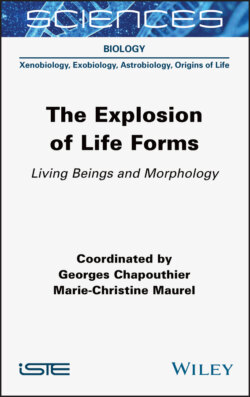Читать книгу The Explosion of Life Forms - Группа авторов - Страница 12
1.2. Have “things” always been as they are today?
ОглавлениеWhat prebiotic chemical reactions can reasonably be simulated in the laboratory? The attributes of today’s living organisms (structures, perennial and hereditary metabolic pathways) have passed through billions of years of planetary, geological and environmental events. Natural selection, by not retaining what was becoming inadequate, has amplified new attempts and taken the place of what was left vacant by recent extinctions, thus favoring innovation. This is how new species settle into diversity.
It is worth recalling that Jean-Baptiste Lamarck, in Philosophie zoologique (1809), was the first to develop a physical theory of living beings, that is to say, an organization of the subject driven by a series of physical processes. He considered that the simplest beings were formed in an appropriate environment in response to physical-chemical laws. According to Lamarck, the living beings resulting from this spontaneous generation adapted to the environment and thus became more “complex”.
The invention of the microscope in the 21st Century revealed that all living organisms are made up of cells of different shapes. Since then, the cell has been regarded as the fundamental structural and functional biological unit of all living beings.
A student of Justus von Liebig, Moritz Traube, developed an “artificial mineral cell” from copper and potassium ferrocyanide in 1867. He observed the growth and budding of structures that resembled cell-like forms like those observed by Robert Hooke in 1665.
Then, Stéphane Leduc, inventor of the term “synthetic biology” (1912), declared at the beginning of the 20th Century, despite the craze for chemistry at the time: “Why is it less acceptable to try to find out how to make a cell than to make a molecule?”
Later, in the 1920s, the Soviet biochemist Alexander Oparin and the English geneticist John Burdon Sanderson Haldane proposed that elementary bricks of life, formed from gaseous elements in the atmosphere, were deposited in the primitive ocean, creating a “prebiotic soup” rich in assorted molecules that, when assembled, formed protocells or coacervates. From then on, all sorts of microspheres, micelles, protobionts and other models of single cells were imagined to represent simple compartments.
In order to “come alive”, the first processes were therefore able to take place in micro-environments that were capable of keeping the different components close to each other, thus promoting their interactions. Initially, this could be in the hollow of a rock or on clay dust, then in tiny organic vesicles, a kind of small bag that fills with molecules until it splits in two.
Coacervates were synthesized in a laboratory in the 1930s by Bungenberg de Jong. Proteinoids (Fox 1988), microspheres, marigranules and other compartmentalizing structures were obtained in order to mimic early cell forms.
In 1951, the young biochemist Boris Pavlovitch Belooussov, who worked in the Biophysics Laboratory of the Ministry of Health of the USSR, wanted to create an inorganic reaction that was similar to the energy-producing reaction in all aerobic organisms. Such a pathway, called the “Krebs cycle” (or “citric acid cycle”, abundant in lemons), works in living cells to break down sugars and produce energy. Belooussov mixed bromate ions BrO3- with citric acid C6H8O7 in the presence of ceric ions Ce4+ in an acidic medium. He hoped to reduce cerium (4+) to cerium (3+), which would have caused a discoloration in the solution. However, his observations were quite different, since he noticed a periodic succession of colors and discolorations of the reaction medium: Belooussov had just discovered the first oscillating reaction by chance. Ten years later, Anatol Zhabotinsky confirmed these observations, which had previously received little credit, and in turn described these oscillating, colored and “budding” waves, which earned the two authors the Lenin Prize for the now famous Beloousov-Zhabotinsky reaction. These observations inspired Heinz von Foerster’s (1961) and Henri Atlan’s (1972) theories on selforganization, Francisco Varela’s autopoiesis (1974) and Ilya Prigogine’s (1947) “thermodynamics far from equilibrium”, with related speculations on the origins of life.
